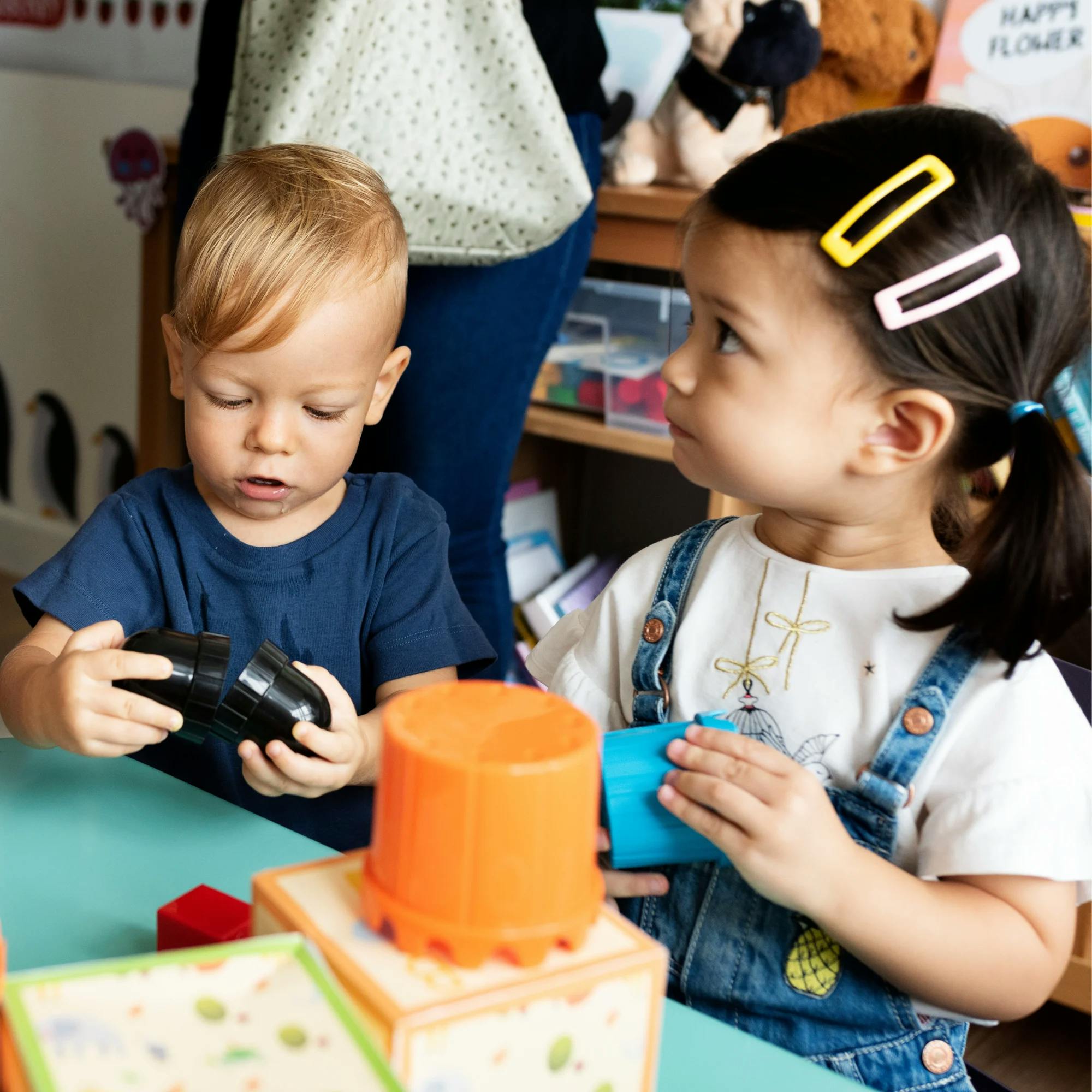
Signs Your Child May Have an Expressive Language Disorder

Expressive language describes how we use words, sounds, or gestures to communicate. As children develop language, there may be a delay in their expressive language. These issues can affect your child’s behavior, academics, and emotional life. Learn the signs of expressive language disorder and how to help your child.
“Oh, she said she wants another cookie.” “Yes, he does like giraffes.” “He wants Grandma to read to him tonight.” If you’re a parent or caregiver, you might be able to relate to “decoding” your child’s speech for other people. I just did it the other night with my 7-year-old while we were at dinner with Grandpa. If this feels familiar, your child may have a limited vocabulary or get frustrated when trying to talk. These could be signs of an expressive language disorder—but you won’t know until you have more information. Keep reading to learn about expressive language disorder and when speech therapy may be needed.
Curious or concerned?
Our free screener is tailored by age and covers all areas of speech, language, and feeding. Find out if your child might need speech therapy.
 Screener for children
Screener for childrenHow to use this guide
There’s a lot of information packed into this guide. You can read through it all for a thorough understanding on the topic. Or, you can find the information that applies most to your situation and child. Then, here’s what to do next:
1. Skim the age section for a quick look at what to expect in language development.
2. Use the milestones to decide if it’s time for an evaluation.
3. Start with one or two home strategies while you schedule next steps.
What is expressive language disorder?
First, there are two terms that we should describe. Those are receptive language and expressive language. Here’s how Alexis Irazoque, M.S., L/SLP, a speech-language pathologist with Expressable, defines each:
Receptive language is how well a child understands what they hear. Examples include:
Following directions
Understanding questions
Recognizing the meaning of words and sentences
Expressive language is how a child uses language to share their wants, needs, thoughts, and feelings. This can happen with words, phrases, sentences, gestures, and facial expressions.
An expressive language disorder is a type of developmental language disorder. Your child may struggle to get their message or meaning across to others. This might look like:
Using fewer words than expected for their age
Using tenses incorrectly (for example, saying “I runned” instead of “I ran”)
Struggling to remember words or form sentences
“A child with expressive language disorder might understand what’s being said but have trouble finding the right words, forming sentences, or clearly expressing their ideas,” says Irazoque. Expressive language problems affect 5% to 8% of children.

Language milestones by age
Language develops with age. What’s expected from a preschooler or grade schooler differs from a toddler. Below, we asked Irazoque for quick checks by age for expected expressive language milestones. This is by no means diagnostic, but it can provide a rough idea of typical development.
Toddler (2-3 years)
Uses 50+ words
Uses short, two-word phrases, such as “more milk” or “go outside”
Preschool (3-5 years)
Uses three- to four-word phrases
Speech is easier to understand for familiar and unfamiliar listeners
Early school-age (5-7 years)
Can tell short stories about their day
Uses more advanced sentence structures using “and” or “because” to connect ideas
Older children & teens
Should be able to organize their thoughts
Uses the right words
Keeps stories and conversations clear and logical

Language delay vs. disorder: What’s the difference?
Children can have a language delay or a language disorder. An expressive language delay means that your child is following the typical path. However, they reach milestones later than expected for their age. A disorder means that their language development is not typical. Generally, this affects their communication. That can lead to problems in academics, behavior in school, and relationships with other kids.
Concerned about your child’s communication? If your child isn’t meeting any of the milestones outlined above, contact a speech therapist for an evaluation. You can work together on a game plan that’s best for your child.
Signs of expressive language disorder by age
As a caregiver, you’re probably the first person to pick up on problems. Although there are specific signs to look for, says Irazoque, they aren’t the only ones. You can trust your gut. “If a child of any age has a hard time clearly expressing their thoughts or ideas, that’s a sign that speech therapy could help,” she says.
Toddlers
Mostly uses gestures, grunts, or single words
Speech is hard to understand
Speech seems to be regressing
Preschoolers
Child avoids talking
Frustrated when trying to communicate
Uses short, incomplete sentences that are hard to follow
Early school-age children
Trouble putting sentences together
Misuses words
Struggles to retell simple events in order
Older children and teens
Child jumps around when telling a story
Leaves out important details
Uses vague words (“thing,” “stuff”) instead of more specific vocabulary

Common look-alikes and rule-outs
Some problems and conditions can mimic the signs of expressive language disorder:
Hearing loss or (repeated) ear infections. Problems hearing may affect speech and language development. Work with your child’s pediatrician to have their hearing and ear health evaluated.
Speech sound disorders. Your child struggles to say common speech sounds, such as “sh.” This may indicate a different type of disorder, such as an articulation disorder.
Attention, learning, or autism spectrum differences. Can occur alongside an expressive language disorder. However, these should be assessed separately.
Bilingualism. Growing up in a bilingual household won’t cause expressive language disorder. However, children who are bilingual are likely to be under- or overdiagnosed for this condition. It’s important for children to be assessed in both of their languages. Developmental delays will show up across all languages they speak.
What causes expressive language difficulties?
There are many potential causes of an expressive language disorder. A child may have an expressive language disorder on its own, or it may be part of a broader diagnosis. Risk factors include:
Family history
Birth complications
Hearing loss
Genetic disorders
Brain injury
Autism
Sometimes professionals can’t identify the cause at all.


How a speech evaluation works
Here’s what you can expect when you see a speech therapist for an evaluation, according to Irazoque:
Caregiver interview: You’ll discuss your child’s communication at home and their developmental history. Now is the time to voice your specific concerns.
Language assessment: The speech therapist will use play-based or structured language assessments. The goal is to understand your child's vocabulary, sentence formation, and idea expression. Tools like the OWLS-II may be used. (This is the Oral and Written Language Scales, Second Edition.) For one task, your child may look at a picture and describe what’s happening.
Child observation: The therapist will be watching how your child interacts and communicates during the evaluation.
“The process is designed to be engaging and comfortable for the child. It will give us the information we need to guide us to next steps,” says Irazoque.
Afterward, the speech therapist will talk to you about possible treatment, including speech therapy. They can also discuss goals and supportive strategies you can use at home and in the classroom.
Expressive language disorder treatment and support options
There are many ways you can support your child’s language development:
Speech-language therapy: Look for a licensed speech therapist for in-person or virtual therapy. Both options are effective for treatment. To learn more about Expressable's approach, check out our treatment guide to language disorders.
Parent coaching: See below for some easy, natural ways you can model language for your child at home.
Classroom supports: Are your teachers up to speed with your child’s language development? Talk with them about ways to support your child at school.
AAC: This stands for augmentative and alternative communication. AAC can include low-tech tools like picture cards, or devices like tablets.
One common myth is that a child will grow out of a language problem like this, especially if they’re a boy, says Byron Ross, Ph.D., CCC-SLP, Instructional Professor in the Department Communication Sciences and Disorders at the University of Houston. “But early intervention is the key to addressing any language issue,” he says. Earlier diagnosis leads to earlier treatment and better progress and development.


Home practice: Simple routines that work
You can support your child by modeling, or showing how to use, language. This is different from asking your child to say something, says Ross. Let's say your child only uses two or three words to get their point across. Many parents are likely to ask them to say it in a full sentence.
Instead of asking your child to repeat after you, simply model the language. “Children learn the language they hear, so modeling good language is important,” Ross says. Here’s what that might sound like:
If your child says “I see doggy.”
Avoid saying “Say ‘I see a doggy walking.”
You can say “Yes, I see that big doggy walking too! His brown hair looks so soft!”
Don’t hesitate to make expressive language fun and playful. There are lots of ways to do this! Irazoque encourages caregivers to:
Narrate everyday activities. “We’re washing the apples!”
Emphasize simple sounds (like “m” or “b”) and animal and vehicle sounds.
Use grammar in conversation (“He’s jumping!” “We walked home”).
When your child expresses themselves, count it as a big win. “Celebrate every attempt to communicate,” Irazoque says.

Classroom vs. home tips
Talk to your child’s speech therapist for personalized ideas for home and school. To get you started, here are some ideas:
At home, ask your child to describe a picture from the day. At dinner, play conversation games, such as “Tell me 3 things about,” “Rose/Thorn,” or “Would you rather?” Choose one that’s age-appropriate for their development.
In the classroom, ask your child's teacher for areas where your child needs the most help. Work together to decide the best ways to support your child. The teacher might use word banks or graphic organizers, or give your child more time to think before answering questions. Discuss how they can model language instead of correcting your child in class. Your speech therapist can even put together a list of ideas or techniques to share with the teacher.
How to create an inclusive environment
We want to honor all forms of communication, not just verbal speech. If your child is nonverbal, your speech therapist might suggest using AAC, or alternative communication devices. These methods do not stop children from talking, says Ross. It’s not true that using a device creates a reason for kids to never learn to speak.
“The research actually suggests the opposite. A child actually becomes more verbal when using an AAC device,” he explains. Why? These devices also help model language.
Working with a speech therapist
You, your child, and the speech therapist can make a great team. “I love when caregivers want to be actively involved. It truly makes such a difference,” says Irazoque. Here are a few things she recommends:
Share observations and updates. Bring notes from teachers, short video clips, or other examples to therapy sessions.
Set goals together. Do you want to help your child ask for what they need? Do you want them to be able to share complete stories? Tell your speech therapist what will be most meaningful and useful to your child’s growth.
Practice at home. Ask your speech therapist for activities that you can use in your daily routines. “Kids learn best when they’re communicating with the people they love most,” says Irazoque.
Ask questions. Ask about progress, strategies to use, or other things you can do at home.
Be patient and positive. It can take time to make progress. Celebrate new words and phrases, and praise your child’s attempts to communicate.


Frequently asked questions
What is an example of an expressive language disorder?
Expressive language is how we express themselves through words, sounds, and gestures. An expressive language disorder is when a child struggles to communicate. They may struggle to share their needs, thoughts, and feelings.
What is an example of a language processing disorder?
Language processing disorder is a learning disability where a person struggles to process information. This can cause difficulty understanding and/or using language, causing communication problems.
Can expressive language disorder be corrected?
Absolutely. Speech therapy is an effective treatment for expressive language disorder. Therapy can help your child in many ways. They can expand their vocabulary, use more complex sentences, and learn to communicate ideas.
Is expressive language disorder autism?
No, expressive language disorder is not autism. Autism is one risk factor that makes a child more likely to have a language disorder. Speech therapy is a treatment for expressive language disorder. If your child has autism, speech therapy may be one type of therapy recommended for your child.
How can I help a child with language processing disorder?
First, seek out an evaluation from a licensed speech therapist. Speech therapy can help your child develop language and communication skills. Support their growth with at-home strategies. Read to your child, model language often, and follow the recommendations from your speech therapist.
Key takeaways
Expressive language disorder describes difficulties communicating. Your child might struggle with using words, forming sentences, or clearly expressing ideas.
Many times, the cause is not known. However, risk factors include hearing loss, autism spectrum disorder, and family history.
Speech therapy is an effective treatment for expressive language delay or disorder. You can attend in-person or virtual sessions.
Early intervention, as well as parent modeling at home, is the best way to support your child.
How Expressable Can Help
Concerned your child isn't reaching age-expected milestones? Looking for communication support from a professional? Expressable is a national online speech therapy practice serving children and adults. We treat all major areas of communication and feeding, offer flexible hours including evenings and weekends, and accept most major health insurance plans. We’re proud to have earned more than 3,000 5-star reviews from our clients (4.9/5 average).
Our therapy model is centered on parent and caregiver involvement. Research proves that empowering caregivers to participate in their loved one’s therapy leads to better outcomes. That’s why we combine live, 1-on-1 speech therapy with personalized education and home practice activities for faster progress.
Communication is more than words. It’s how we share how we feel and show who we are. We’re here to help you or your child do just that.








